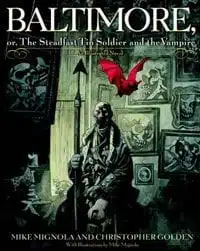
If we take for granted the idea that there are, by definition, no good wars, we can at least entertain the theory that some wars are at least worse than others. To that end, it seems particularly clear that among recent conflagrations, the one named at the time with an unconscious but bitter irony The War To End All Wars deserves to rank up there with the worst of all time. Helping put a nail in the fantasy that modern warfare could ever be described as chivalrous or valorous to any extent, the years of mud-slogging trench warfare and the millions of youthful lives mown down for quickly forgotten reasons (a treaty? Some archduke getting assassinated down in the Balkans?) were a butcher’s delight of pointless savagery; rich material for any genre scribe worth their salt. In their thoughtful, studied illustrated novel Baltimore, or, The Steadfast Tin Soldier and the Vampire, novelist Christopher Golden and Hellboy scribe Mike Mignola (who also did the hundred-plus shadowy and expressionist illustrations that liberally pepper the text) make full use of World War I’s carnival of cruelty to foreground their tale of lost love and massacred innocence. Not to mention vampires — lots of vampires.
Baltimore isn’t quite a graphic novel, though its story closely resembles one. The idea is that the charnel fields of the Western Front had proved good feeding grounds for bat-formed vampires, who were content to feast on the carrion soldiers. That is, until a British officer (Lord Baltimore) near death in no man’s land, wounds one of the feeding bats with his bayonet. This simple act of self-defense enrages the vicious creature and unwittingly unleashes a vampire war on humanity that would look to the unknowing world like the Spanish Influenza epidemic which began sweeping like a scythe across the planet in the last year of the war. It’s a clever trick to pull with history, and one that Mignola has been doing for quite some time with Hellboy, a series that toys around in the shadowy cracks and crevices of the recorded past, finding those places dark enough where mystery and magic can still prosper.
One is aware of being in the hands of a pair of seasoned practitioners of high gothic moderne from the very opening line:
On a cold autumn night, under a black sky leached of starlight and absent the moon, Captain Henry Baltimore clutches his rifle and stares across the dark abyss of the battlefield, and knows in his heart that these are the torture fields of Hell, and damnation awaits mere steps ahead.
While in most settings this sort of description would come off as nothing more than overwrought hackery, given the hellacious reality of the Western Front during this period, it’s not so far off from the truth. Having established themselves in a world wherein their already horrific imaginations can hew close to what actually is without trying too hard, Mignola and Golden use that grim backdrop to launch readers further into their operatic story of revenge.
Having survived his encounter with the undead, albeit now with a wooden leg, Baltimore returns to his familial town in England only to have the vampire plague deprive him of his family and beloved. Turned thusly into a doomed knight of vengeance out of some medieval tale, Baltimore stumps restlessly from one end of the world to the next, the embodiment of untiring dedication as exemplified in the Hans Christian Andersen story of “The Steadfast Tin Soldier,” selections from which punctuate the chapters here. Baltimore seems primarily a Mignola creation, though, and so is outfitted properly, with a long black coat and carrying a harpoon taller than himself, while “a pair of rifles hung from his back and other weapons were belted all over his body” — his wooden leg is studded with nails, one for every vampire he’s sent to hell.
If Baltimore were simply a Hellboy-esque actioner, though, it wouldn’t pack quite the sting that it does. Baltimore himself stays to the background for most of the book, which is structured for the most part around one long night in which three men — accomplices of Baltimore who all know him from different walks of life — meet up in the inn of a plague-infested town to wait for their mutual friend who called them there, and to swap tales of the unreal in the meantime. Each of the men has witnessed in his own life episodes of macabre terror, which they then reluctantly spin out in the gloom as they wait, each one a perfectly framed gothic fairytale of the highest order. In these stories, whether about a haunted theater or a village terrorized by an evil night-spirit, the book takes on a classically menacing hue.
For all the book’s pulp trappings and vampire-war bloodletting, Golden and Mignola understand quite well, better than most of their contemporaries, the simple thrill of a well-told spook story spun out in dramatic segments by shadowy characters in seedy settings.
